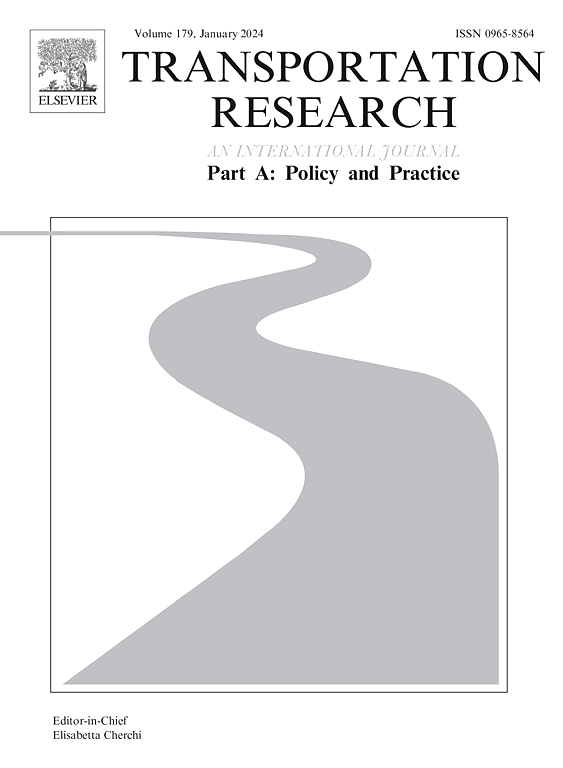Can transit apps boost ridership? An empirical study in San Antonio, Texas
IF 6.3
1区 工程技术
Q1 ECONOMICS
Transportation Research Part A-Policy and Practice
Pub Date : 2025-05-24
DOI:10.1016/j.tra.2025.104526
引用次数: 0
Abstract
In the past decade, an increasing number of smartphone transit apps have become available for transit riders to pay fares, plan trips, and check real-time vehicle information. Despite the growing popularity of transit apps, their impact on transit ridership is still not well understood. This study investigates the impact of the VIA goMobile app on bus ridership using longitudinal panel data on route-level monthly ridership in San Antonio, Texas. This quasi-experimental study employed random-effect (RE) regression models to evaluate the influence of the transit app on ridership from 2015 to 2019 while controlling for various ridership influencers, such as transit fare, route characteristics, weather, socioeconomic conditions, and gas prices. This study deployed 59 RE models to examine the relationship between the app deployment and ridership changes over time for both frequent and infrequent bus routes. The findings revealed that the app exerted a significant positive impact on ridership for infrequent bus routes but not for frequent ones. The app’s positive effect on ridership for infrequent bus routes grew more pronounced after its launch. Since the VIA goMobile app became available, infrequent routes experienced an average increase of 1,634 trips per route per month, translating to $99,840 in monthly revenue. The study contributed to the understanding of transit apps and provided insights into how transit apps can be strategically deployed to enhance different types of bus services. These findings offered valuable insights for transit industry leaders to evaluate the cost and benefits of transit apps and make informed decisions about effective ridership-boosting strategies.
公交应用程序能提高客流量吗?德克萨斯州圣安东尼奥市的实证研究
在过去的十年里,越来越多的智能手机交通应用程序可供交通乘客支付票价、计划行程和查看实时车辆信息。尽管公交应用程序越来越受欢迎,但它们对公交乘客的影响仍未得到很好的理解。本研究使用纵向面板数据调查了VIA移动应用程序对德克萨斯州圣安东尼奥市公交月均客流量的影响。这项准实验研究采用随机效应(RE)回归模型来评估2015年至2019年公交应用程序对客流量的影响,同时控制各种客流量影响因素,如公交票价、路线特征、天气、社会经济条件和汽油价格。本研究部署了59个RE模型,以检查应用程序部署与频繁和不频繁公交路线的客流量变化之间的关系。研究结果显示,该应用程序对不频繁的公交线路的乘客产生了显著的积极影响,而对频繁的公交线路则没有影响。这款应用在推出后对不太频繁的公交线路的客流量产生了积极影响。自从VIA移动应用程序上线以来,不太频繁的路线平均每月增加了1634次旅行,每月收入达到99840美元。这项研究有助于理解公交应用程序,并为如何战略性地部署公交应用程序以增强不同类型的公交服务提供了见解。这些发现为公交行业的领导者评估公交应用程序的成本和收益提供了宝贵的见解,并为有效的客流量提升策略做出明智的决策。
本文章由计算机程序翻译,如有差异,请以英文原文为准。
求助全文
约1分钟内获得全文
求助全文
来源期刊
CiteScore
13.20
自引率
7.80%
发文量
257
审稿时长
9.8 months
期刊介绍:
Transportation Research: Part A contains papers of general interest in all passenger and freight transportation modes: policy analysis, formulation and evaluation; planning; interaction with the political, socioeconomic and physical environment; design, management and evaluation of transportation systems. Topics are approached from any discipline or perspective: economics, engineering, sociology, psychology, etc. Case studies, survey and expository papers are included, as are articles which contribute to unification of the field, or to an understanding of the comparative aspects of different systems. Papers which assess the scope for technological innovation within a social or political framework are also published. The journal is international, and places equal emphasis on the problems of industrialized and non-industrialized regions.
Part A''s aims and scope are complementary to Transportation Research Part B: Methodological, Part C: Emerging Technologies and Part D: Transport and Environment. Part E: Logistics and Transportation Review. Part F: Traffic Psychology and Behaviour. The complete set forms the most cohesive and comprehensive reference of current research in transportation science.

 求助内容:
求助内容: 应助结果提醒方式:
应助结果提醒方式:


